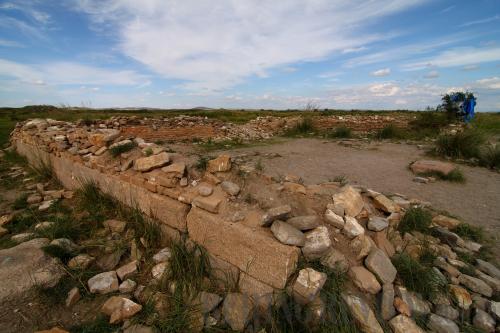|
 |
|
HINT OF HISTORY: Crumbled remains of Xanadu's ancient city wall at the southeast Mongolian Plateau (CFP) |
This summer marks the revival of an ancient Chinese city that once captivated the world with its great wealth and mystery—a place where Kublai Khan (1215-94) once ruled, and which was later immortalized by the writings of Marco Polo (1254-1324) and British poet Samuel Taylor Coleridge (1772-1834).
Xanadu earned a spot on the World Heritage List on June 29. The announcement was made at the 36th session of the UNESCO World Heritage Committee in St. Petersburg, Russia. It marks China's 30th World Cultural Heritage site and 42nd World Heritage site.
"Xanadu is the best-preserved of the Yuan Dynasty's (1271-1368) capital cities and has lasted the longest. It's the only intact evidence of the rise and fall of the Yuan Dynasty, which saw the unique fusion of agrarian Han and nomadic Mongolian civilizations in northern Asia," said Tong Mingkang, Deputy Director of State Administration of Cultural Heritage.
Located in the Inner Mongolia Autonomous Region, Xanadu was made the first capital city of the Yuan Dynasty after its construction beginning in 1256. The Yuan Dynasty is the first national regime in Chinese history that was established by a minority—the Mongolians.
Located in Zhenglan Banner and Duolun County of the Xilin Gol League in central Inner Mongolia, Xanadu became the summer capital of the Yuan Dynasty after Kublai Khan conquered central China to establish the Yuan Dynasty in 1271.
The heritage site covers a total area of 251 square km. Shaped like a square, it has a central axis marked by imperial palaces. The site also includes neighborhoods outside the city gates, the urban flood control channels and several graveyards.
With a buffer area of 1,507 square km, the newly established heritage site covers traditional cultural features such as the Mongolians' Obo Worship Festival, and unique geological landscapes including wetlands, steppe formations, forest steppes and sands.
Though the city lies in ruins, the view from the highlands overlooking mountainous scenery envelops a visitor in beauty while offering a glimpse of the site's former glory.
"The site is more intact than any of the remaining locations that I've seen. The city walls, gates and streets are easy to spot. The collapsed buildings all remain in their original place, so we can easily identify them," said Wei Jian, an archaeologist.
In 2009, following approval by the State Administration of Cultural Heritage, the Xanadu archaeological exploration and excavation project was officially launched.
"During three years from 2009 to 2012, altogether we discovered the remnants of more than 1,000 houses, nearly 700 building bases and unearthed thousands of relics. We also found more than 30 roads and five stagnant lakes," said Wei Wei, an employee of the Xanadu Site Museum.
These discoveries proved that since the city was abandoned at the beginning of the Ming Dynasty (1368-1644)—a dynasty ruled by Han Chinese following the Yuan Dynasty—it has been kept intact in a natural state until today, with rich historical and cultural remains left underground, said Wei.
In fact, the journey to promote Xanadu as a World Heritage site began in 1996. After 16 years of dedicated efforts, it has finally brought the honor back home.
According to the World Heritage Committee, the former capital city's remains displayed characteristics of cultural integration, having witnessed the collision and integration between nomadic and farming civilizations hundreds of years ago.
The committee confirmed that the site met the organization's authenticity and integrity requirements, and approved of the protection and continued enhancement of management efforts on the site.
Xanadu's entrance into the World Heritage List will further enrich the value and variety of all World Heritage sites. It will contribute to the sustainable development of such prized locations, said Tong.
When applying for World Heritage site status, a fundamental requirement is that the place must possess exceptional universal value, said Tong.
As the earliest and best-preserved Yuan capital city with a unique urban structure, Xanadu bears significant value to human civilization. Located in the connecting zone between vast agricultural land and a pasture area in north Asia, the former capital was a melting pot for the assimilation of farming and nomadic peoples during the Yuan Dynasty.
As an example of this integration, Xanadu holds a unique place in the world history of city planning and design.
The designer of Xanadu was Liu Bingzhong, an accomplished Han politician and scholar who served Kublai Khan. While planning the city, he skillfully integrated the Han architectural style into the surrounding prairie environment, thereby forming the city with both farming and nomadic cultural traits. And as the Yuan Empire grew in global dominance, Western civilizations entered the scene to further enhance the city's cultural diversity.
| 